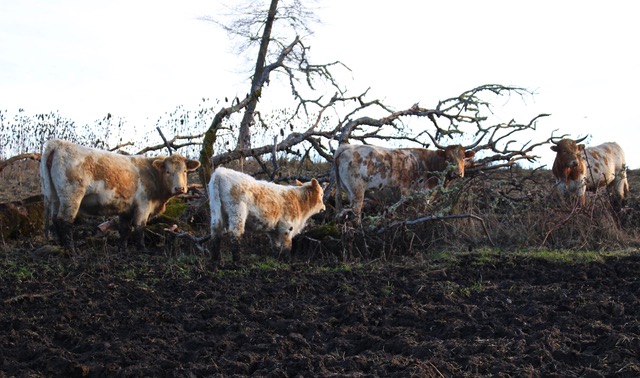Maysara Wines
The youngest of our six children was home a couple of months ago from UCSB for an extended winter break. And after a couple of weeks, Lizzy was eager to switch things up a bit from helping with the routine domestic B & B chores, so I suggested she grab her camera and head over to Maysara Winery with me and set her eye on capturing some great blog photos.
After meandering down the long driveway, through gently rolling fields of vines, and a group of curious horned cattle, we pulled up to the massive Maysara facility. Entering through what felt like a castle door, we met Dominic at the far end of a long, highly polished log hewn tasting bar. Lizzy and Dominic easily struck up a lively conversation. She, being a UCSB Environmental major, was quite taken with Dominic’s detailed descriptions of Maysara’s biodynamic practices which strummed all the right chords of Lizzy’s “save the earth” creed!
The name Maysara, translated from Old World Farsi, means “House of Wine” and denotes the Persian influence of the Momtazi family on their craft. The family venture began when Moe and Flora Momtazi purchased 496 acres of farmland in 1997. After adding some additional acreage, the Momtazis currently own 532 acres of pristine vineyard, worked completely according to biodynamic principles. Nearly 20 years ago, this land was meticulously transformed partially from an old abandoned wheat farm and has been kept free of chemicals ever since. Grapes are tended to with natural sulphur, phosphate, and stinging nettle tea applications also grown on the property. The essence of Maysara’s biodynamic methods go back to Old World farming techniques that were harmoniously natural; for example working with lunar cycles in planting, fertilizing, and harvest. From the harvest, the Momtazi’s three daughters create a superior wine product continuing the biodynamic principles from the vines to production. As such, Maysara is one of the very few wineries that maintain the consistency of biodynamic practices from vineyard to table.
With regard to specific varietals, Maysara Vineyard began by planting 13 acres of French Pommard grapes for Pinot Noir. After researching the best Pinot varietals, the Momtazis grafted 120,000 starts in their green house and then planted them all by the end of summer 1999. Together with ideal vineyard soil, the unique climate of the Momtazi vineyard perfectly enhances the quality of their grapes. Geographically, Maysara sits relatively close to the Mid-Oregon coast. It is a location that maintains the warm valley temperatures during the day while experiencing cooler nights due to coastal winds making their way inland through the Van Duzer Corridor. This allows Maysara grapes to reach their peak characteristics several weeks later then those growing in the nearby Willamette Valley. Magnificent!
If Maysara’s ideal location, environmentally sound vineyard and production practices were not reason enough to catch the attention of discriminating wine enthusiasts, the Maysara Estate creates further intrigue with a production facility and tasting room comparable in size to that of a blimp hanger. The structure, spanning approximately an acre, is constructed with wood and stone gleaned from the property; all the way down to the walkways, bar, and table tops. Adding to the grandness and character of this setting are the enormous facility walls all completely lined with straightened barrel staves from over 1100 old neutral oak wine barrels.
While taking in the grandeur, Lizzy and I enjoyed sampling wines that spend up to 18 months in a combination of new and neutral French Oak barrels; lending to a more Burgundian style of wine. One particular exception was the Anahita Riesling, which is fermented in large concrete “eggs” prior to transfer to stainless steel barrels. Characteristics of this wine includes a crispness of Granny Smith apples with a fleeting hint of lemon. Also of note is Maysara’s Cyrus Pinot Noir named after Cyrus I, the last Persian King. King Cyrus, also an avid wine enthusiast back in the day, was known for planting vineyards and producing wine throughout his realm. Maysara’s Cyrus Pinot Noir is aged for 18 months in 30% new French oak and 70% neutral oak. This creates a wine that hits with fruitiness mid-palate, while finishing boldly. Quite fitting for a Persian King!






